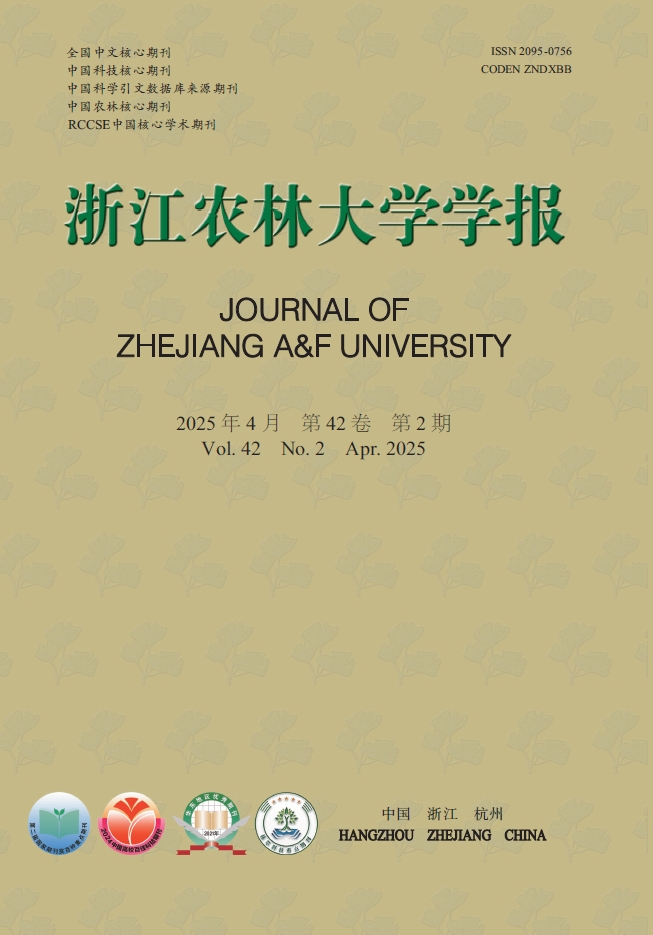-
茄子Solanum melongena是茄科Solanaceae茄属Solanum的 1年生草本植物,以浆果为产品器官,作为重要的蔬菜,在中国南北方被广泛栽培[1]。茄子果实营养丰富,富含多酚、花色苷和芦丁等营养物质,具有较高的食用价值与医疗保健功效[2−7]。茄子种质资源十分丰富,中国目前已建立了较成熟的国家茄子种质资源数据库管理系统和地方茄子种质资源数据库[8]。王佳慧[9]基于表型性状对142份茄子进行遗传多样性分析,发现不同茄子种质资源农艺性状存在较大差异,并从中筛选出了品质佳、抗寒性强的优良种质。张念等[10]采用形态标记对76 份茄子种质资源进行遗传多样性分析,发现种质资源间形态性状差异明显,基于Pearson系数聚类将其分为3类7组。陈雪平[11]利用形态标记对133份茄子种质及其近缘种进行分析,发现茄子形态遗传变异丰富,可作为植物学分类的重要依据。齐东霞等[12]利用表型性状对105份中俄茄子种质材料进行分析,发现材料间表现出不同程度多样性,表型聚类发现类群划分与地理来源没有直接关系,但与茄子果实性状存在一定相关性。
主成分分析法是通过降维方法将数量多且相关的变量重新组合,形成个数少、彼此独立并能尽量反映原变量相关信息的综合变量,简化了多个指标,为资源的评价和选择提供科学依据[13]。目前,主成分分析法被广泛应用于水稻Oryza sativa、玉米Zea mays、油茶Camellia oleifera、小麦Triticum aestivum、南瓜Cucurbita moschata等多种作物[14−18],而中国在茄子农艺性状和品质评价方法及评价指标方面的研究较少,影响了茄子资源利用、新品种选育及市场竞争力的提升。
本研究以10份茄子种质资源为材料,通过测定并分析不同茄子品种农艺性状及果实品质等,采用主成分分析法对12个指标进行综合分析,构建科学的评价体系,以期为优质茄子资源或品种的快速筛选及新品种选育提供依据。
-
试验在杭州市临安区清凉峰茄子基地进行。供试茄子品种有‘紫龙5号’‘紫龙7号’‘亮紫7号’‘浙茄10号’‘杭茄716’‘杭茄718’‘Z1’‘Z2’‘Z3’‘杭茄2020’等10个品种。日常栽培管理采用相同标准进行,2024年6月底采收每个品种盛果期果实,并立即运至浙江农林大学园艺学院实验室测定相关指标。
-
每个品种材料随机选取10株,测定株高、株幅、茎粗等农艺性状。果实长度、横径、单果质量、果实颜色、果实硬度等指标测定均有10个生物学重复。采用色差仪(CR-10)测定茄子的果皮颜色[19],获得L、a、b值。L代表亮度,a代表红绿度,即颜色的红绿差异,b代表蓝黄度,即颜色的蓝黄差异。采用蒽酮比色法[20−21]测定可溶性糖质量分数。采用G-250考马斯亮蓝法[22]测定可溶性蛋白质量分数。采用茚三酮比色法[23]测定游离氨基酸质量分数。采用福林酚法[24]测定总酚质量分数。采用物性测试仪(TA-XT plus)对茄子果实进行穿刺分析。试验中采用的探头为圆柱形P/2E探头,直径为2 mm,测试参数如下:测前速度为1 mm·s−1,测试速度为1 mm·s−1,测后上行速度为1 mm·s−1。
-
将茄子农艺性状和品质指标作为变量,导入SPSS 19.0进行标准化处理。利用软件中的因子分析对茄子性状进行主成分提取及相关性分析。采用方差贡献率作为主成分提取标准,计算主成分贡献率,根据特征向量,计算各主成分得分表达式,综合评价时对各指标进行无量纲化。
-
茄子农艺性状测定重复10次,品质指标测定重复5次,采用Excel和SPSS 19.0对数据进行分析处理。文中数据均为平均值±标准差。
-
由表1可知:10个品种茄子的植株高度为91.00~114.00 cm,其中‘Z2’最高,其次是‘亮紫7号’,‘杭茄718’最矮。各品种间株幅差异较大,株幅最大的是‘紫龙7号’,为100.00 cm,其次是‘紫龙5号’‘浙茄10号’‘杭茄718’,这3个品种间无显著差异。‘亮紫7号’的株幅最小,只有‘紫龙7号’的62.67%。10个品种茄子的植株茎粗为1.74~2.42 cm,其中‘杭茄716’最粗,显著高于其他品种(P<0.05),茎粗最小的是‘Z3’。
品种 株高/cm 株幅/cm 茎粗/cm 品种 株高/cm 株幅/cm 茎粗/cm ‘紫龙5号’ 101.33±2.73 c 97.00±5.48 b 2.04±0.18 bcd ‘杭茄718’ 91.00±1.90 e 96.00±3.41 b 2.17±0.13 b ‘紫龙7号’ 95.17±1.83 d 100.00±3.35 a 1.92±0.17 cde ‘Z1’ 98.67±4.55 cd 82.17±3.49 c 1.86±0.14 de ‘亮紫7号’ 112.33±4.63 a 62.67±3.33 f 2.13±0.25 bc ‘Z2’ 114.00±7.97 a 73.50±3.02 e 2.00±0.13 bcd ‘浙茄10号’ 107.33±3.72 b 97.00±1.90 b 1.97±0.21 bcd ‘Z3’ 100.67±9.20 c 77.00±3.46 d 1.74±0.14 e ‘杭茄716’ 102.33±2.25 c 83.67±4.97 c 2.42±0.37 a ‘杭茄2020’ 96.00±4.20 d 76.67±4.27 d 2.15±0.24 b 说明:同列不同小写字母表示同一指标不同品种间差异显著(P<0.05)。 Table 1. Agronomic characteristics comparison of 10 eggplant cultivars
-
10个茄子品种均为紫色品种。由表2可知:‘杭茄718’的L最高,说明其果实表面光泽度最好,‘Z3’的L最低。10个茄子品种的a为9.20~14.33。‘Z1’果皮的a最大,色泽最深,达14.33, ‘杭茄718’次之,‘Z3’的a最小,只有‘Z1’的64.20%。b均为负数,说明所有果实都没有偏黄的。
品种 皮色 长度/cm 横径/cm 单果质量/g L a b ‘紫龙5号 −0.45±0.10 bc 10.20±1.48 ef −4.55±0.87 a 33.87±1.48 de 2.48±0.10 c 101.82±7.96 bcd ‘紫龙7号’ −0.35±0.13 b 13.25±0.50 bc −7.28±0.26 e 29.47±0.40 h 2.35±0.16 d 98.08±5.84 d ‘亮紫7号’ −0.40±0.12 bc 11.45±1.04 d −5.78±0.78 c 35.10±2.47 c 2.43±0.10 c 113.55±10.42 a ‘浙茄10号’ 0.03±0.03 a 12.60±0.14 c −6.78±0.62 d 33.42±1.29 ef 2.30±0.15 d 103.99±5.10 bcd ‘杭茄716’ −0.40±0.08 bc 12.68±0.92 c −6.70±0.93 d 32.37±1.84 g 2.75±0.14 a 109.08±8.49 abc ‘杭茄718’ 0.08±0.05 a 13.55±0.25 ab −7.03±0.46 de 34.67±2.25 cd 2.48±0.10 c 109.98±16.86 ab ‘Z1’ 0.05±0.06 a 14.33±1.10 a −7.45±0.49 e 37.87±1.54 a 2.62±0.18 b 106.51±7.58 abcd ‘Z2’ −0.48±0.17 c 9.73±0.59 fg −5.53±0.94 bc 34.57±1.33 cd 2.70±0.09 a 105.65±4.20 abcd ‘Z3’ −0.63±0.10 d 9.20±0.84 g −4.48±0.46 a 36.47±1.12 b 2.70±0.18 a 105.90±2.29 abcd ‘杭茄2020’ −0.38±0.05 bc 10.90±0.60 de −5.15±0.44 b 32.80±2.60 fg 2.45±0.10 c 100.61±7.16 cd 说明:同列不同小写字母表示同一指标不同品种间差异显著(P<0.05)。 Table 2. Comparison of fruit traits of 10 eggplant cultivars
各茄子品种的果实长度为29.47~37.87 cm,其中‘Z1’果实最长,显著高于其他品种(P<0.05)。果实最短的品种是‘紫龙7号’,显著低于其他品种(P<0.05)。果实横径最大的3个品种是‘杭茄716’‘Z2’‘Z3’,显著高于其他品种(P<0.05)。果实最细的品种为‘浙茄10号’,仅为2.30 cm。不同品种茄子的单果质量存在一定差异,其中‘亮紫7号’单果质量最大,‘紫龙5号’单果质量最小。
-
茄子果皮和果肉的穿刺试验发现(图1A):各品种间果皮硬度存在差异,‘杭茄716’果皮硬度最大,显著高于其他品种(P<0.05),‘杭茄2020’次之,‘Z3’果皮硬度最小,仅为‘杭茄716’果皮硬度的55.05%;‘紫龙5号’‘紫龙7号’‘亮紫7号’‘杭茄718’的果皮硬度相近,无显著差异。各茄子品种果肉硬度的变化规律跟果皮硬度一致(图1B)。‘杭茄716’果肉硬度最大,‘杭茄2020’次之,‘Z3’果肉硬度最小,仅为‘杭茄716’果肉硬度的53.97%;‘紫龙5号’‘紫龙7号’‘亮紫7号’‘杭茄718’的果肉硬度相近,无显著差异。‘浙茄10号’‘Z1’‘Z2’果肉硬度差异不大。不同茄子品种间果皮韧性差异较大(图1C)。‘亮紫7号’果皮韧性最大,‘杭茄718’和‘浙茄10号’果皮韧性最小。‘紫龙5号’‘Z1’‘Z2’的果皮韧性差异不大。‘杭茄716’和‘杭茄2020’的果皮韧性最小,且两者之间无显著差异。
-
由表3可知:茄子果实可溶性糖质量分数最高的品种为‘Z2’,达38.04 mg·g−1,其次是‘浙茄10号’,为35.35 mg·g−1,‘杭茄718’可溶性糖质量分数最低,只有25.01 mg·g−1,显著低于其他品种(P<0.05)。茄子果实可溶性蛋白质量分数较高的3个品种为‘Z1’‘Z2’‘Z3’,显著高于另外7个品种(P<0.05)。‘亮紫7号’和‘紫龙5号’果实游离氨基酸质量分数最高,达1.7 mg·g−1,‘杭茄2020’游离氨基酸质量分数最低,仅为0.73 mg·g−1,显著低于其他品种(P<0.05)。‘紫龙7号’‘亮紫7号’‘杭茄718’‘杭茄2020’的总酚质量分数最高,显著高于其他品种(P<0.05),‘Z1’总酚质量分数最低,只有2.21 mg·g−1。
品种 可溶性糖/(mg·g−1) 可溶性蛋白/(mg·g−1) 游离氨基酸/(mg·g−1) 总酚/(mg·g−1) ‘紫龙5号’ 30.04±2.59 cd 3.53±0.65 b 1.69±0.06 a 4.08±0.67 bc ‘紫龙7号’ 34.53±2.91 abc 3.79±0.69 b 1.42±0.13 b 5.26±0.74 a ‘亮紫7号’ 32.62±1.04 bcd 3.54±0.42 b 1.76±0.26 a 5.19±0.88 a ‘浙茄10号’ 35.35±2.69 ab 3.66±0.27 b 1.09±0.15 c 3.60±0.91 bc ‘杭茄716’ 33.88±2.65 abc 3.14±0.55 b 1.17±0.12 bc 2.94±0.38 cd ‘杭茄718’ 25.01±1.03 e 3.90±0.65 b 1.36±0.13 bc 4.78±0.68 a ‘Z1’ 35.19±2.67 ab 5.03±0.38 a 1.12±0.19 c 2.21±0.72 d ‘Z2’ 38.04±2.73 a 4.68±0.25 a 1.19±0.23 bc 3.24±0.58 cd ‘Z3’ 32.14±3.45 bcd 4.79±0.20 a 1.27±0.23 bc 4.44±0.62 ab ‘杭茄2020’ 28.09±3.40 de 3.64±0.26 b 0.73±0.13 d 4.78±0.68 a 说明:同列不同小写字母表示同一指标不同品种间差异显著(P<0.05)。 Table 3. Comparison of fruit quality of 10 eggplant cultivars
-
对10个茄子品种的16个性状指标进行主成分分析,得到了特征值大于l的5个主成分,反映了总信息量的87.126% (表4)。第1主成分的方差贡献率为28.125%,其中可溶性蛋白、长度、株高、果皮韧性、可溶性糖、横径等具有较大的载荷值,综合反映了茄子产量、果实、品质等各方面的性状,因此,第1主成分能作为选择综合性状较好的优质茄子种质资源的有效指标。第2主成分的方差贡献率为21.098%,果肉硬度、果皮硬度、茎粗、株高等具有较大的载荷值,主要反映了茄子植株的生长性状。第3主成分的方差贡献率为16.474%,特征向量值较大的是单果质量、横径、色差a、茎粗等,主要反映了茄子的商品性状。第4主成分的方差贡献率为11.444%,特征向量值较大的是游离氨基酸、单果质量和果皮韧性。第5主成分特征向量值中较大的是长度和单果质量,其他指标的载荷值不突出,但增加了整个模型的信息表达量,更能全面反映茄子的综合性状。
主成分 特征值 方差贡献率/% 累计方差贡献率/% 1 4.500 28.125 28.125 2 3.376 21.098 49.224 3 2.636 16.474 65.697 4 1.831 11.444 77.141 5 1.598 9.985 87.126 Table 4. Characteristic value and cumulative variance contribution rate of eggplant evaluation factors
为了消除不同单位及数据量纲的影响,对各性状指标的原始数据进行了无量纲化处理。根据表5构建了主成分(F1~F5)与茄子各生物学性状(X1~X16)间的线性关系式:
性状 主成分 性状 主成分 1 2 3 4 5 1 2 3 4 5 茎粗(X1) −0.663 0.560 0.407 0.132 0.052 b (X9) 0.431 0.589 −0.525 −0.210 0.253 株高(X2) 0.573 0.402 0.180 0.254 −0.470 果皮硬度(X10) −0.755 0.579 0.237 −0.123 −0.025 株幅(X3) −0.546 −0.573 −0.284 −0.096 −0.155 果皮韧性(X11) 0.509 0.311 0.144 0.422 −0.267 长度(X4) 0.698 −0.168 0.377 0.083 0.529 果肉硬度(X12) −0.660 0.603 0.363 −0.208 −0.022 横径(X5) 0.402 0.376 0.513 −0.443 0.210 可溶性糖(X13) 0.475 −0.050 0.300 −0.115 −0.797 单果质量(X6) 0.191 0.261 0.585 0.539 0.404 可溶性蛋白(X14) 0.766 −0.457 0.125 −0.274 0.162 L (X7) −0.328 −0.758 0.398 0.241 0.132 游离氨基酸(X15) 0.163 0.172 −0.246 0.787 −0.056 a (X8) −0.531 −0.587 0.492 0.257 −0.078 总酚(X16) −0.261 0.178 −0.748 0.366 0.198 Table 5. Rotated component matrix of the principal component analysis
在主成分分析基础上,以5个主成分和每个主成分对应特征值占提取主成分总特征值之和的比例作为权重,计算主成分综合模型(F):F=0.28F1+0.21F2+0.16F3+0.11F4+0.10F5,根据综合模型计算不同茄子品种的综合性状得分(表6)。结果表明,‘亮紫7号’的综合性状最好,其次是‘Z1’,‘紫龙7号’的综合性状最差。
品种 F1 F2 F3 F4 F5 F 排名 ‘紫龙5号’ 0.08 0.66 −1.81 0.44 0.35 −0.05 6 ‘紫龙7号’ −1.87 −1.36 −1.88 0.18 0.14 −1.08 10 ‘亮紫7号’ 1.19 1.54 0.20 3.08 2.45 1.27 1 ‘浙茄10号’ −0.62 −1.72 −0.16 0.08 0.06 −0.55 7 ‘杭茄716’ −2.58 2.68 2.64 −0.87 −0.69 0.10 5 ‘杭茄718’ −2.19 −1.22 0.24 0.99 0.78 −0.64 8 ‘Z1’ 2.98 0.63 0.59 −0.75 −0.59 0.92 2 ‘Z2’ 2.96 0.47 −1.44 −1.29 −1.02 0.45 3 ‘Z3’ −1.72 1.38 −0.94 −1.69 −1.34 −0.66 9 ‘杭茄2020’ 1.76 −3.06 2.57 −0.17 −0.13 0.23 4 Table 6. Characteristics prediction results of different eggplant varieties
-
中国茄子种质资源一般采用形态学的方法进行分类。近年来,分子标记在茄子种质资源分类上开始广泛应用。易金鑫[25]根据茄子形态学分类指标,将亚洲部分茄子种质资源分为野生茄、半栽培茄、栽培短茄(圆茄、卵茄)和栽培长茄。连勇等[26]根据各地区主要种植茄子果形、果色的差异,将国家蔬菜种质资源中期库保存的茄子及其近缘野生种资源分为7 个地方品种类型分布区,即圆果形茄子区(北京、河北、山东等)、紫色卵圆(高圆)形茄子区(新疆、宁夏、甘肃等)、黑紫色长棒形茄子区(黑龙江、辽宁、吉林等)、紫色棒形及卵圆形茄子区(云南、重庆、四川等)、紫红色长果形茄子区(广东、广西、海南等)、紫红色长棒形及卵圆形茄子区(安微、湖南、江西等)和紫红色长条形茄子区(浙江、上海、福建等)。本研究采用的10个茄子品种都是紫红色长条形茄子。对茄子农艺性状、果实性状及品质特性等进行测定,发现不同品种的株高、株幅、茎粗等农艺性状差异显著,果实长度、质地、果皮颜色等也存在较大差异,可溶性糖、可溶性蛋白、游离氨基酸等品质指标差异显著。这与前人研究结果一致[9−11]。房超等[27]采用简单重复序列(SSR)标记对83份茄子种质资源进行多样性和聚类分析,发现茄子栽培种和其近缘野生种存在明显差异,并将供试材料分为4大类群。赵德新[28]对55份茄子种质材料进行形态标记和简单重复序列区间扩增(ISSR) 标记聚类分析,发现果形是茄子分类比较稳定的划分标准。本研究采用主成分分析也发现,第1主成分中果实长度和横径均具有较大的载荷值,说明果形可以作为选择综合性状较好的优质茄子种质资源的重要指标。
果实质地特性可以反映产品的耐贮性。本研究发现‘杭茄716’的果实硬度和果皮硬度均显著高于其他品种,说明该品种的耐贮性比较好。主成分分析法能简化测定指标,提取主要因子,借助计算机软件对其进行综合分析与排序。李伟等[29]利用主成分分析法评价不同地区35个品种杨梅Myrica rubra的综合品质,筛选出了品质较佳的杨梅品种。滕芝妍等[18]对南瓜进行主成分分析,揭示了不同品种南瓜果实品质的差异。本研究对10个茄子品种进行主成分分析,得到5个主成分,影响力较大的是株高、果实长度、果皮韧性、可溶性糖质量分数等,综合反映了植株生长、果实性状、果实品质等方面性状,较客观地揭示了茄子种质资源特征。不过,茄子生长发育受到生长环境和气候条件的影响,下一步可以基于主成分分析法针对不同季节、不同区域和不同栽培条件下的茄子品种进行综合评价。
-
本研究测定了10个茄子品种的植株生长、果实商品性状及品质性状等16个相关指标,比较茄子品种间的差异,并在此基础上采用主成分分析法对不同茄子品种进行综合评价,确立了茄子评价综合得分模型。10个品种中,‘亮紫7号’的综合性状最好,其次是‘Z1’,而‘紫龙7号’的综合性状最差。该模型能够全面反映不同茄子品种的综合性状差异,可为茄子种质资源筛选和新品种选育提供理论依据和技术支撑。
Comprehensive evaluation of Solanum melongena cultivars
doi: 10.11833/j.issn.2095-0756.20240394
- Received Date: 2024-06-10
- Accepted Date: 2024-11-06
- Rev Recd Date: 2024-10-30
- Available Online: 2025-04-01
- Publish Date: 2025-04-01
-
Key words:
- eggplant /
- cultivars /
- principal component analysis /
- comprehensive evaluation
Abstract:
| Citation: | YING Xuebing, CHEN Pingmei, LI Luyao, et al. Comprehensive evaluation of Solanum melongena cultivars[J]. Journal of Zhejiang A&F University, 2025, 42(2): 357−364 doi: 10.11833/j.issn.2095-0756.20240394 |











 DownLoad:
DownLoad: